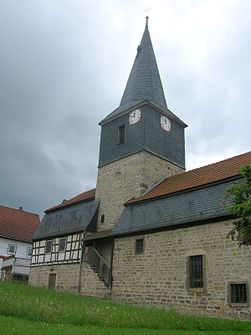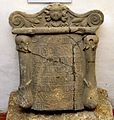Bittstädt
|
Bittstädt
Municipality of Wachsenburg
Coordinates: 50 ° 50 ′ 10 ″ N , 10 ° 53 ′ 17 ″ E
|
|
|---|---|
| Height : | 366 m above sea level NHN |
| Area : | 8.21 km² |
| Residents : | 583 (Jun 15, 2009) |
| Population density : | 71 inhabitants / km² |
| Incorporation : | June 30, 1994 |
| Incorporated into: | Wachsenburg community |
| Postal code : | 99334 |
| Area code : | 03628 |
|
Village church of St. Giles
|
|
Bittstädt is a district of the municipality of Amt Wachsenburg in the Ilm district ( Thuringia ). It has about 600 inhabitants.
geography
The place is about four kilometers west of the district town of Arnstadt on the edge of the Ohrdruf military training area .
history
In 786, Bittstädt was first mentioned as an act of petition in an exchange document of the goods lent by Archbishop Lullus (710–786) of Mainz for the monastery of Hersfeld from Free . Over the centuries the place was named as Bizzostat (i) (before 815), Bystete (1301), Am Bisteter Weg (1419) and Bidtstädt (1571). The name is interpreted as the site of the Bizzo , the farm of a free farmer. The Benedictine monastery in Arnstadt acquired larger properties in Bittstädt and built a farmyard. In the Middle Ages, viticulture was practiced , later woad cultivation. The place belonged to the Amt Wachsenburg , which in 1640 came to the Duchy of Saxe-Gotha , from 1672 to the Duchy of Saxe-Gotha-Altenburg and in 1826 to the Duchy of Saxe-Coburg and Gotha .
Brick production, which had started around 1860, was later discontinued due to transport difficulties. The parish chronicle lists two fires that caused damage to the place: 1689 and 1766: The information that a fire raged in 1689 comes from Beck , who reports on the destruction of the parish and school house. He must have been wrong, however, as there never was a rectory in Bittstädt and, from 1689, major construction costs for the school building are not shown.
Since 1994, the village has belonged to the Wachsenburg community based in nearby Holzhausen . With the dissolution of the municipality on December 31, 2012, the place came to the municipality of Wachsenburg .
Culture and sights
- The place is widely known for the "Bittstädter Liedertafel Choir", which was formed from the formerly usual group of singers. The association was founded on February 24, 1862 with the ducal confirmation of the choir regulations drawn up by teacher and choirmaster Julius August Lencer . In 1993 the association was awarded the Zelter badge .
- Even before 1651, when Duke Ernst the Pious from Gotha issued a fire armament regulation, according to which the places in the duchy had to provide their own fire brigades, there was organized fire fighting in Bittstädt, as can be seen from a municipal bill from 1592/93. An inventory list mentions 10 leather buckets , three poker hooks and three scaling ladders . In 1866 the formation of a new fire brigade was reported to Gotha.
- The village church of St. Aegidien is essentially Romanesque. The choir tower church with its nave was probably extended in 1677, followed by further alterations in 1690, 1701 and 1749. The choir was added and expanded in the 18th century. The church has a choir tower with a helmet and lantern and to the east of it a choir extension with a plastered half-timbered upper floor. Inside the church there is a two-story gallery built around on three sides.
- In 1985 the church received a new organ from the workshop of the Gotha organ builder Gerhard Böhm . It has five registers , a manual and a pedal .
- Galletti wrote about the church that they had a beautiful pulpit with the images of the four evangelists, the same of the holy. Aegidius, and the one who gave the church these portraits, namely Nicolaus Stumms, a practicing doctor who was born here . The exquisitely painted portrait of Christ, which hangs near the pulpit, comes from the same . The very beautiful pulpit with the painting on the wooden staircase and the baptismal font are from the 17th century. The image of Christ was rediscovered and restored in 2016. The last church renovation took place from 1978 to 1985.
- The church
- The Christmas market on the last Saturday before the 1st Advent, which is valued beyond the municipality's borders, has now become a tradition.
- The disused gravel pit Heidenholz (see section Economy and Infrastructure )
- A section of the old copper road between Hohenkirchen and Arnstadt, now designated as a hiking trail, leads over the Kirchberg near the village ( location → ) .
- Every year the Schelli Memorial Run takes place in Bittstädt (on the Eichfeld ( Lage → )), a popular biker meeting that commemorates the fatally injured Arnstadt biker named Schellhorn .
- The place used to have a brick factory, but today nothing can be seen of it except the fallow site of the former production facility ( location → ).
- According to Galletti , the place owned the so-called holy well in 1780 (at the time G. was describing it) on a meadow near the village […], to which in olden times it was heavily pilgrimaged. One therefore suspects that the name of the place means something like a Bethstedte . The holy spring mentioned by Galletti ( Lage → ) is still bubbling, but no longer has a “holy” character and is no longer visited by pilgrims. Today it feeds a small concrete container with water, which is about 50 m below, and from which the citizens draw water for their watering cans.
- Some beautiful old half-timbered buildings and the street names Klostergasse and Mönchhof suggest that there was once a monastery in the village, which is not true. Here was only the farm yard of a monastery. The only reference to this was a note in the original local chronicle that the property and land changed hands. This local chronicle, however, "miraculously" disappeared in 1989/90. In the church there is a tombstone of the Princely Saxon forester Isaac Jacobi, who had lived in the Bittstädter Mönchsgut since 1661 and who acquired the neighboring rights for Bittstädt. The Mönchsgut (also Propsteigut) was a Freihof , the owner of which did not have to perform any tensioning services. (So the text on the information board on the tombstone).
- Gutshof, Kupferstrasse and Hl. Quelle
Economy and Infrastructure
Gravel has been mined in the area around Bittstädt for many decades . The now closed gravel pit Heidenholz is part of the Geopark Inselsberg - Drei Gleichen as a natural monument . In Heidenholz, the community has created a stage for choir singing and other events. In the early 1990s, Hanson Germany GmbH & Co. KG set up a new gravel plant.
The place has road connections to Arnstadt and Holzhausen. There is a regular bus service to Arnstadt Monday to Friday.
Sons and daughters of the church
- Sebastian Bodinus (1700–1759), composer
- Julius August Lencer (1833–1903), composer, choirmaster and pomologist
literature
- Adolf Gabler: Bittstädt - A history and homeland reading book. Arnstadt 2011
Web links
- Page about Bittstädt on the website of the Wachsenburg community
- Website of the Liedertafel association in Bittstädt
Individual evidence
- ^ Galletti: History and description of the Duchy of Gotha , Gotha 1780, p. 316.
- ^ Statement by the current village chronicler, Josef Löffler
- ↑ National GeoPark Thuringia Inselsberg - Three Equals. 1. Implementation phase. Expert office Reyer, Erfurt 2009, p. 12, accessed on October 13, 2010 (PDF; 1.7 MB)











